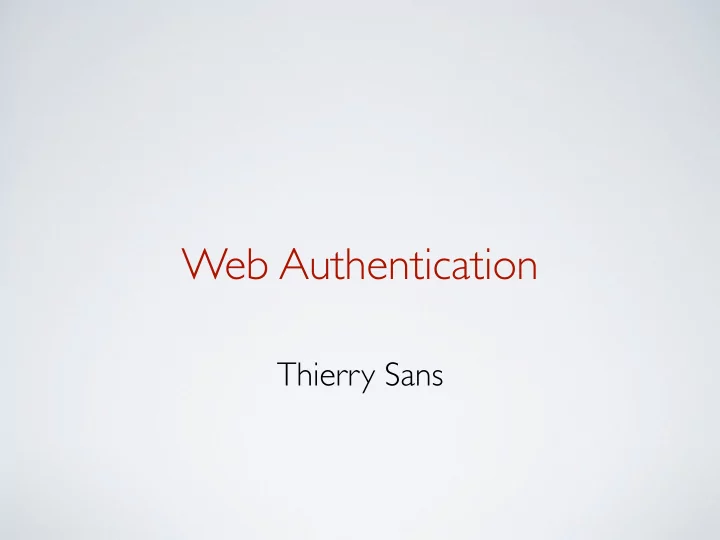

Web Authentication Thierry Sans
Several Methods • Local authentication with login and password • Token-based authentication • Third party authentication
Local Authentication
How to store and verify password? • Clear Data can be hacked A key is needed to store • Encrypted and verify passwords • Hash Weak passwords have known hash Salt and hash must be stored • Salted Hash
Basic Authentication (stateless) (Standard) RFC 2617 ➡ Login and password are sent in clear (Base64 encoding) in the headers "authorization" $ curl -u login:password http://url $ curl http://admin:password@url
Session Authentication (stateful) (Standard) RFC 6265 1. The user enters a login and password and the frontend send them to the backend (POST request) 2. The backend verifi es the login/password based on information stored on the server (usually in the database) 3. The backend stores user information in a session 4. The backend grants access to resources based on the information contained in the session
Do/Don't with passwords • On the client side, do send passwords in: ✓ headers (automatic with basic authentication) ✓ body (POST request with session authentication) ๏ never in the URL • On the server, do store passwords as ✓ salted hash passwords only ๏ never in clear
Token-based Authentication
HMAC (Standard) RFC 2104 For each authenticated HTTP request, the frontend computes and send a message digest that combines the user's secret and some request arguments ✓ User's password never transit back and forth (except the first time it is exchanged maybe) ✓ Digest can be send in clear
JSON Web Token (Standard) RFC 7519 Encode user information in a string that is URL safe (token) Token are usually authenticated and sometimes encrypted ✓ Web token can be used for stateful but yet session-less authentication ๏ revoking tokens can be complicated https://medium.com/@yuliaoletskaya/can-jwt-be-used-for-sessions-4164d124fe23
Third-party Authentication
Single-Sign-On (SSO) 1998 • Pubcookie (a.k.a webiso) 2005 • OpenID 2005 • SAML (a.k.a Shibboleth) • OAuth 2010 • Mozilla Persona 2011 among others …
OAuth 2 (Standard) RFC 6749 1. The backend redirects the user to the third-party login-page 2. Third-party asks and verify the login/password based on the third- party user information 3. Third party redirects the user back to the application with a OAuth token and verifier in the url 4. Backend verifi es the token with third party 5. Backend starts a session ➡ User's login/password never transit by the application frontend nor backend
source: Choosing an SSO Strategy: SAML vs OAuth2
Recommend
More recommend